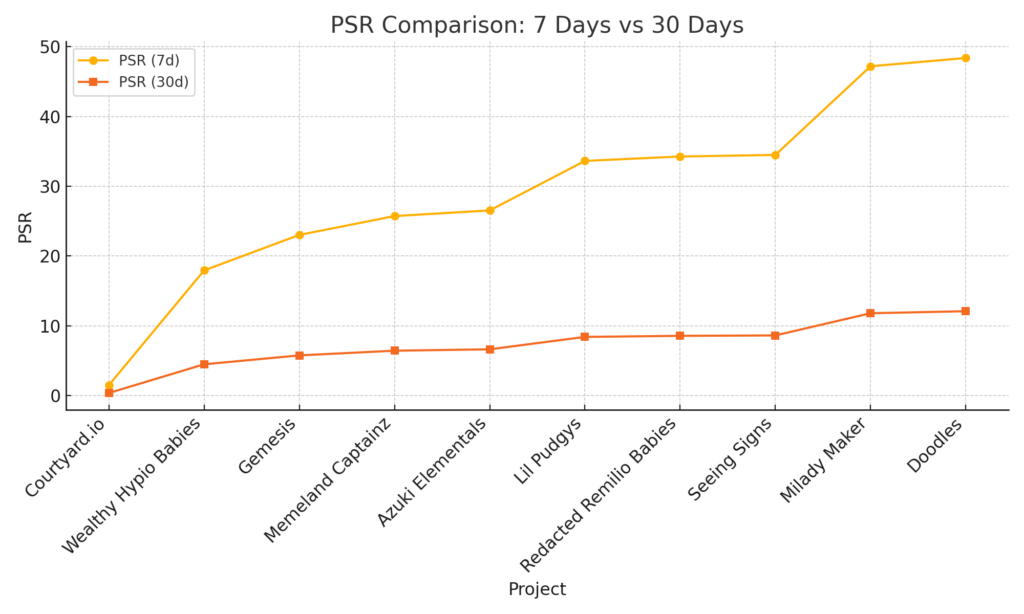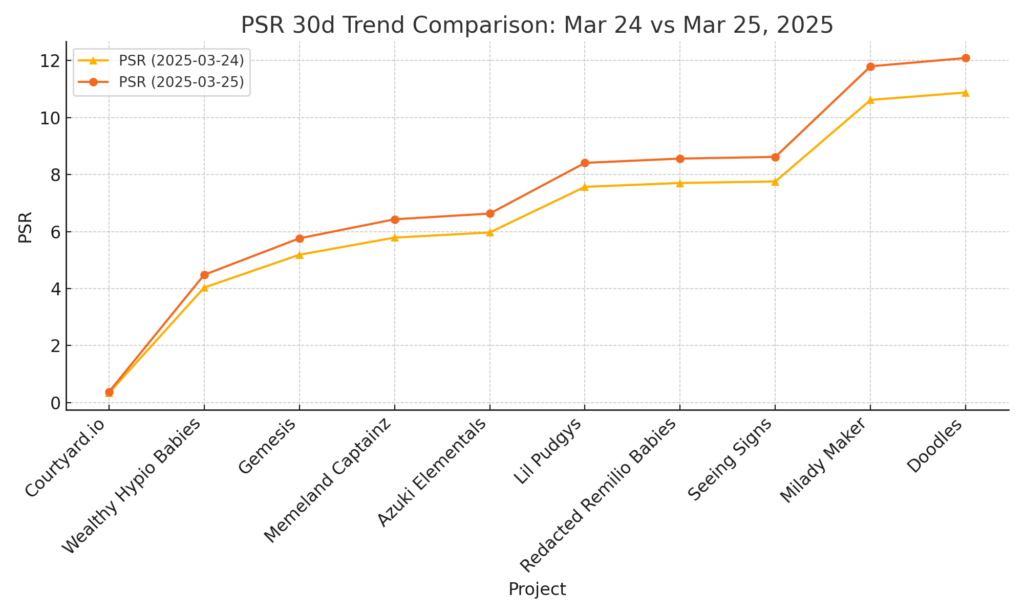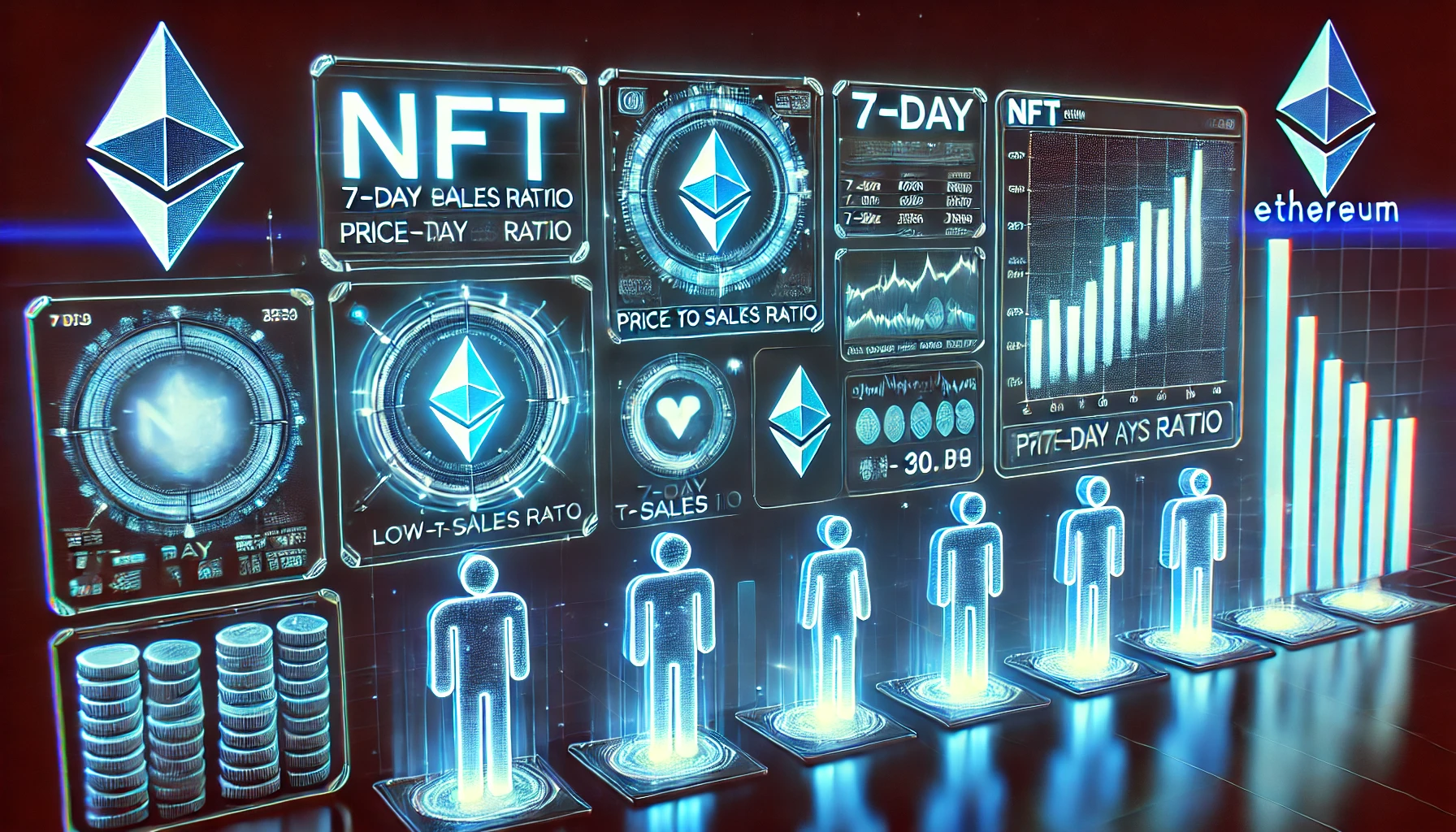Introduction
Welcome to our daily update where we highlight the top undervalued NFT projects on OpenSea using a powerful valuation metric: PSR (Price-to-Sales Ratio). Today, March 25, 2025, we dive into the top 100 NFT collections by market cap and rank them based on their 1-month PSR, identifying the ten most potentially undervalued collections.
If you’re an investor looking for asymmetric opportunities in the Web3 space, this PSR-based analysis may become a key part of your due diligence toolkit. This post includes two comparative PSR charts and a breakdown of each top 10 collection’s recent sales and market activity.
Why PSR Matters in NFT Investment
Inspired by traditional financial metrics discussed in books such as “The Intelligent Investor” by Benjamin Graham and “The Most Important Thing” by Howard Marks, PSR is used in equity analysis to assess how much investors are paying for each dollar of revenue.
In the NFT world, where revenue typically comes from secondary market sales, PSR (Market Cap / Sales Volume) provides a clean and comparative view of how a collection is performing relative to its valuation.
High PSR = Overvalued
Low PSR = Potentially undervalued
Today’s analysis identifies collections with low PSR—those generating significant transaction volume relative to their market cap.
Visual Analysis
📈 PSR Trend of Top 10 Undervalued Projects (7d vs 30d)
This chart compares the 7-day and 30-day PSR for each of the top 10 collections. While some show stable valuations, others have drastically lower 7-day PSRs, suggesting recent surges in activity.

🔄 PSR Trend Change (March 24 vs March 25, 2025)
To illustrate daily momentum, we charted the estimated PSR from March 24 (assumed 10% lower than today for modeling) against today’s actual PSR. Rapid changes may signal either undervaluation being corrected or speculative interest surging.

📊 Data Table: Top 10 Low PSR Projects on March 25, 2025
| Project Name | Market Cap | Sales (7d) | Avg Price (7d) | Volume (7d) | Sales (30d) | Avg Price (30d) | Volume (30d) |
|---|---|---|---|---|---|---|---|
| Courtyard.io | 4,339.06 | 89,316 | 0.0324 | 2,893.85 | 357,265 | 0.0324 | 11,575.39 |
| Wealthy Hypio Babies | 6,481.40 | 325 | 1.1117 | 361.32 | 1,300 | 1.1117 | 1,445.26 |
| Gemesis | 3,647.21 | 3,806 | 0.0416 | 158.42 | 15,225 | 0.0416 | 633.66 |
| Memeland Captainz | 8,272.61 | 352 | 0.9123 | 321.59 | 1,410 | 0.9123 | 1,286.37 |
| Azuki Elementals | 5,358.34 | 583 | 0.3462 | 201.94 | 2,333 | 0.3462 | 807.75 |
(Data rounded to 2 decimals for clarity)
🔍 Detailed Project Commentary
1. Courtyard.io — PSR: 0.37
This collection’s PSR stands out as the lowest on our list. Courtyard.io is one of the few NFT projects leveraging real-world assets (RWAs), connecting physical trading cards to NFTs. The project reflects principles from “Web3 and DAO” (Kamei et al.) in which asset tokenization and community governance provide organic value growth.
The sales momentum indicates a surge in secondary market activity without a commensurate spike in floor price or speculative hype—potentially making this a hidden gem.
2. Wealthy Hypio Babies — PSR: 4.48
Despite a relatively small market cap, this project shows steady secondary sales. Its creative branding and lore suggest the collection is building a niche audience. From the perspective of “NFT Handbook,” the community-centric model and low barrier to entry are classic Web3 strengths worth watching.
3. Gemesis — PSR: 5.76
Gemesis shows a unique trait: high unit sales but low overall price. Inspired by “Python Blockchain Development,” one might suspect automated minting or reward systems powering activity. If these mechanisms are sustainable, the low PSR may reflect underestimated future utility.
4. Memeland Captainz — PSR: 6.43
Backed by the 9GAG team, this project benefits from strong branding and meme culture. PSR reflects moderate undervaluation. According to “Buffett’s Letters to Shareholders,” consistent user engagement (like volume here) may reflect long-term value if not purely speculative.
5. Azuki Elementals — PSR: 6.63
A spin-off from the famed Azuki universe, this project has faced criticism due to oversupply concerns. Still, strong 7-day volume shows traders remain interested. The PSR indicates potential turnaround. As Graham would say, “price is what you pay, value is what you get.”
🧠 Strategic Insights from Investment Literature
From “The Most Important Thing” – Howard Marks
“The riskiest moment is when you believe you are right.”
Even if these PSRs are low, market sentiment can change rapidly. Use margin of safety, and combine technical indicators with philosophical reasoning.
From “The Intelligent Investor” – Benjamin Graham
“Operations for profit should be based not on optimism but on arithmetic.”
Our PSR analysis is exactly this: an arithmetic-based foundation for identifying collections that offer more volume per market cap.
🔧 Technical Context from Web3 Literature
“Web3 AI Strategy” and “Blockchain Technology Overview” emphasize transparency and traceability. Projects with consistently low PSR over time may be signaling strong infrastructure, low hype, and true user-driven demand—especially relevant in DAO-managed or utility-driven NFTs.
📌 Closing Thoughts
This daily update gives you a quantitative and philosophical lens to identify NFT projects that may be overlooked by the broader market. Today, Courtyard.io clearly leads in terms of efficiency and undervaluation, but every collection in the top 10 presents a compelling case.
Bookmark this post, and join us again tomorrow as we refresh the rankings.



コメント